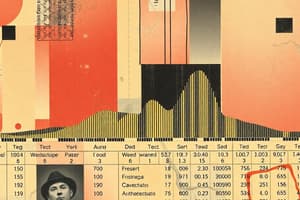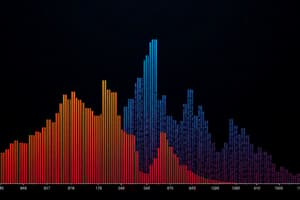Podcast
Questions and Answers
In a frequency table, what does the cumulative frequency represent?
In a frequency table, what does the cumulative frequency represent?
- The difference between the highest and lowest frequencies.
- The average frequency across all values.
- The sum of frequencies up to and including a certain value. (correct)
- The number of times a specific value appears.
The mode is always equal to the median in a normally distributed dataset.
The mode is always equal to the median in a normally distributed dataset.
False (B)
What measure of central tendency is most affected by outliers in a dataset?
What measure of central tendency is most affected by outliers in a dataset?
mean
In a skewed right distribution, the ______ is typically greater than the median.
In a skewed right distribution, the ______ is typically greater than the median.
Match each term with its correct definition:
Match each term with its correct definition:
Which of the following is NOT a measure used in creating a box-and-whisker plot?
Which of the following is NOT a measure used in creating a box-and-whisker plot?
A z-score of 0 indicates that the data point is equal to the mean.
A z-score of 0 indicates that the data point is equal to the mean.
What does a negative z-score indicate about a data point's position relative to the mean?
What does a negative z-score indicate about a data point's position relative to the mean?
The formula for calculating the z-score is: z = (x - μ) / ______, where x is the individual score and μ is the mean.
The formula for calculating the z-score is: z = (x - μ) / ______, where x is the individual score and μ is the mean.
Which of the following statements is true regarding the shape of a distribution?
Which of the following statements is true regarding the shape of a distribution?
Standard deviation measures the spread of data around the median.
Standard deviation measures the spread of data around the median.
What is the first step in calculating standard deviation from a set of data?
What is the first step in calculating standard deviation from a set of data?
Q1 represents the ______ percentile of the data.
Q1 represents the ______ percentile of the data.
What does a box-and-whisker plot visually represent?
What does a box-and-whisker plot visually represent?
A negative standard deviation indicates a flaw in the dataset or calculation
A negative standard deviation indicates a flaw in the dataset or calculation
How do you determine if a z-score is considered 'unusual'?
How do you determine if a z-score is considered 'unusual'?
The range is calculated as the ______ value minus the lowest value.
The range is calculated as the ______ value minus the lowest value.
Which calculation is necessary to determine relative comparison between data points?
Which calculation is necessary to determine relative comparison between data points?
The formula for calculating the Mean is: Mean = (Sum of all (value + frequency)) ÷ (Total number of students)
The formula for calculating the Mean is: Mean = (Sum of all (value + frequency)) ÷ (Total number of students)
In a box-and-whisker plot, what do the “whiskers” represent?
In a box-and-whisker plot, what do the “whiskers” represent?
Flashcards
Frequency (f)
Frequency (f)
How often a value appears in a dataset.
Cumulative Frequency
Cumulative Frequency
The sum of frequencies up to a certain point in a dataset.
Range
Range
Difference between the highest and lowest values in a dataset.
Median
Median
Signup and view all the flashcards
Mode
Mode
Signup and view all the flashcards
Q1 and Q3
Q1 and Q3
Signup and view all the flashcards
Box-and-whisker plot
Box-and-whisker plot
Signup and view all the flashcards
Mean (x̄)
Mean (x̄)
Signup and view all the flashcards
Standard Deviation Formula
Standard Deviation Formula
Signup and view all the flashcards
Z-Score
Z-Score
Signup and view all the flashcards
Z-Score Formula
Z-Score Formula
Signup and view all the flashcards
Unusual z-scores
Unusual z-scores
Signup and view all the flashcards
Relative Comparison
Relative Comparison
Signup and view all the flashcards
Range Formula
Range Formula
Signup and view all the flashcards
Mode
Mode
Signup and view all the flashcards
Median
Median
Signup and view all the flashcards
Mean Formula
Mean Formula
Signup and view all the flashcards
Q3
Q3
Signup and view all the flashcards
Q1
Q1
Signup and view all the flashcards
Symmetrical shape of distribution
Symmetrical shape of distribution
Signup and view all the flashcards
Study Notes
- Study notes for analyzing data in frequency tables and distributions
Frequency Table Analysis
- Frequency (f) indicates how often a value appears in a dataset.
- Cumulative frequency is calculated by adding each frequency to the sum of the frequencies before it.
- Range is the difference between the maximum and minimum values in a dataset.
- Median is the middle value in a dataset, which can be found using cumulative frequencies.
- Mode is the value that appears most frequently in a dataset.
- Q1 and Q3 represent the 25th and 75th percentiles of the data, respectively.
- Box-and-whisker plots are created using the minimum value, Q1, median, Q3, and maximum value to visualize the distribution.
Measures of Central Tendency
- Mean (x̄) is calculated by summing all values multiplied by their frequencies and then dividing by the total number of values.
- The formula for the mean is x̄ = (Σfx) / n, where f is frequency, x is the data value, fx is f × x, and n is the total frequency.
Shape of Distribution
- Symmetry in a distribution indicates a normal distribution.
- Skewed Right distributions have a tail extending to the right.
- Skewed Left distributions have a tail extending to the left.
- If the mode, median, and mean are all different, the distribution is likely skewed.
Standard Deviation
- Standard deviation measures the spread of data around the mean.
- To calculate it, find the mean, subtract the mean from each value, square the results, find the average of the squared deviations, and then take the square root.
- The formula for standard deviation (σ) is σ = √[(Σ(x - x̄)²) / n].
Z-Score
- Z-score indicates how many standard deviations an individual data point is from the mean.
- The formula for calculating the z-score is z = (x - μ) / σ, where x is the individual score, μ is the mean, and σ is the standard deviation.
- Usual z-scores fall between -2 and +2.
- Unusual z-scores are less than -2 or greater than +2.
Relative Comparison
- Z-scores are used to compare different data points by determining their relative positions within their respective distributions.
Finding the Range
- Range is determined by subtracting the lowest value from the highest value in the dataset.
Finding the Mode
- The mode is the value that appears most often in the dataset.
Finding the Median
- Cumulative frequency is used to find the middle student (n ÷ 2) where n = total number of students.
- Locate which time interval that middle student falls into
Finding the Mean
- Multiply each time value × its frequency
- Add them all up
- Divide by the total number of students.
- The formula is: Mean = (Sum of all (value × frequency)) ÷ (Total number of students)
Finding Q1 and Q3
- Q1 is the median of the lower half of the data (first 25% of students).
- Q3 is the median of the upper half of the data (first 75% of students).
- After finding the overall median, split the data into lower and upper halves and find the median of each.
Shape of Distribution
- Symmetrical distributions resemble a bell curve.
- Skewed left distributions have a long tail on the left (mean < median).
- Skewed right distributions have a long tail on the right (mean > median).
Box-and-Whisker Plot
- Draw a number line that covers all your data
- Plot: Minimum (smallest data point), Q1 (lower quartile), Median (middle), Q3 (upper quartile), Maximum (largest data point)
- Draw a box from Q1 to Q3, and a line at the median.
- Extend “whiskers” from the box to the min and max.
Standard Deviation
- Subtract the mean (x - mean) = deviation and Square the deviation ((x - mean)^2)
- Standard deviation = sqrt[(sum of squares) ÷ (n-1)] (because it’s a sample, not a population.)
Memory Tricks
- Mean = Average (total ÷ how many)
- Median = Middle (when ordered)
- Mode = Most (most frequent)
- Range = Difference (biggest - smallest)
- Standard deviation = How spread out the numbers are
Studying That Suits You
Use AI to generate personalized quizzes and flashcards to suit your learning preferences.




